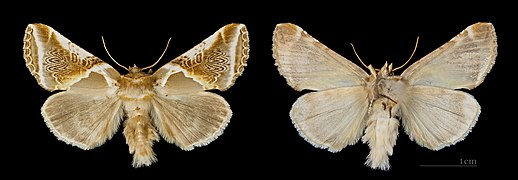Agate owl moth
| Agate owl moth | ||||||||||||
|---|---|---|---|---|---|---|---|---|---|---|---|---|

Agate owl moth ( Habrosyne pyritoides ) |
||||||||||||
| Systematics | ||||||||||||
|
||||||||||||
| Scientific name | ||||||||||||
| Habrosyne pyritoides | ||||||||||||
| ( Hufnagel , 1766) |
The agate owl moth ( Habrosyne pyritoides ) is a butterfly from the family of the owl moth and sickle winged moth (Drepanidae). It is often, however - with us along with the Peach Blossom in a separate family - Owls spinner out.
features
The moths reach a wingspan of 35 to 40 millimeters. Their forewings have a typical and little variable olive, brown, white and yellow coloring and drawing, which is reminiscent of polished agate . They have three white stripes around the front corner that enclose an orange-brown and white patterned triangle. Their hind wings are gray-brown and a little lighter in the middle.
The caterpillars are about 40 millimeters long. The young caterpillars are dark brown to gray-brown and more clearly spotted than the later caterpillar stages. These are brownish red and have a narrow, dark back line with indistinct light side spots. They have white spots on the sides of the three anterior abdominal segments, which become smaller towards the back, or just one such spot on the first abdominal segment.
Occurrence
The animals are common in Europe , except in the far north and parts of the Mediterranean region , east to Japan and are widespread. They live in deciduous and coniferous forests with large stocks of their forage plants, but also in gardens and parks.
Way of life
The agate owl moth are nocturnal and are similar in behavior and appearance to the rose owl ( Thyatira batis ). They too like to fly to artificial light sources.
Flight and caterpillar times
The moths fly in one generation from late May to early August. The caterpillars are found from August to early September.
Food of the caterpillars
The caterpillars eat the leaves of blackberries ( Rubus fruticosus ) and raspberries ( Rubus idaeus ), more rarely also those of hazelnuts ( Corylus ) and hawthorns ( Crataegus ).
development
The females lay their eggs in groups on the edge or directly on the jagged edges of the leaves of the forage plants. The caterpillars are also nocturnal and hide under leaves on the ground during the day. They pupate between spun leaves in a light, brown web and hibernate before they hatch. The moths rarely hatch in late summer.
swell
Individual evidence
- ↑ Manfred Koch : We identify butterflies. Volume 2: Bears, Spinners, Swarmers and Drills in Germany. 2nd, expanded edition. Neumann, Radebeul / Berlin 1964, DNB 452481929 , pp. 120f.
literature
- Heiko Bellmann : The new Kosmos butterfly guide. Butterflies, caterpillars and forage plants. Franckh-Kosmos, Stuttgart 2003, ISBN 3-440-09330-1 .
- Günter Ebert (Ed.): The Butterflies of Baden-Württemberg Volume 4, Moths II (Bombycidae, Endromidae, Lemoniidae, Saturniidae, Sphingidae, Drepanidae, Notodontidae, Dilobidae, Lymantriidae, Ctenuchidae, Nolidae). Ulmer Verlag Stuttgart 1994. ISBN 3-800-13474-8
- Hans-Josef Weidemann, Jochen Köhler: Moths, Spinners and Swarmers . Naturbuch-Verlag, Augsburg 1996, ISBN 3-894-40128-1
Web links
- Lepiforum e. V. Taxonomy and Photos
- Moths and Butterflies of Europe and North Africa (English)
- Guide to the moths of Great Britain and Ireland (English)
- Habrosyne pyritoides in Fauna Europaea

